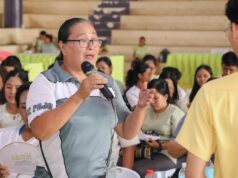SUBIC BAY FREEPORT – The initiatives of the Subic Bay Metropolitan Authority (SBMA) in uplifting the living conditions of the indigenous people (IP) living within the Subic Bay Freeport has become a model for other economic zones hosting similar tribal communities.
Recently, the Ateneo De Zamboanga University (ADZU) invited SBMA Chairman Roberto Garcia to the forum “From Zamboanga to Subic, In Search for Partnership” that aimed to pick up insights from the SBMA’s experiences with the Pastolan Ayta tribe with whom the agency had signed a joint management agreement (JMA) for the use and development of tribal lands.
The forum, which also sought to deepen understanding of the Zamboangueños on the two-fold issue of land use and land ownership between the Subanon tribe and the Zamboanga Economic Zone was held at the Garden Orchid Hotel in Zamboanga City.
ADZU Director Loreta Sta. Teresa said the SBMA inputs will “concretize the writings and the experiences summarized in the book report” developed after conducting a study trip in Subic and Clark freeports.
The forum, Sta. Teresa added, “will be a venue to materialize what ADZU envisioned for a new Mindanao where multi-cultural communities live in peace and harmony.”
In his presentation, Chairman Garcia explained that with the signing of the JMA between the SBMA and the Pastolan Aytas, the indigenous tribe started collecting five percent of the gross income paid by the investors for rent of the land, starting May 12, 2009, the date when the Ayta’s certificate of ancestral domain title (CADT) was registered.
Above this, the SBMA also has started to give each Ayta family P20,000 annually, an amount which is increased further on the 6th, 11th, 16th, and 25th year. The agency also donates P100,000 each year for the fiesta and Christmas celebrations at the Pastolan Ayta village.
Garcia also said that able-bodied Aeta workers are given priority in any job hiring for the construction of the $450-million solar and wind project located at a 20-hectare area near Pastolan.
He added that the SBMA also turned over the management of the Pamulaklakin Tribal Park to the Aytas after completing the transition period for management training.
The Aytas also benefited from SBMA community development assistance programs, the construction of two schoolrooms for high school, and the establishment of a community clinic with detailed medical personnel from the SBMA Dispensary.
Garcia said the SBMA initiated the establishment of the JMA in recognition of the Ambala Ayta tribe of Subic Bay’s CADT, which proves the tribe’s ownership of the more than 4,280 hectares of land covering the Kalayaan and the Binictican housing areas, the Apaliin and the Pamulaklakin forest areas, and the El Kabayo tourism area, among others.
The JMA and its implementing rules and regulations (IRR) were signed by the SBMA management and the Ambala Ayta tribal council in 2013.
The JMA upholds the rights of the Aytas to uplift the economic, cultural and social conditions of their tribe based on the programs being implemented by the government, and provide for a systematic management and development of the ancestral land, as indicated in the Ancestral Domain Sustainable Development and Protection Plan, while ensuring the promotion of Ayta rights.
National Commission on Indigenous Peoples (NCIP) Chairperson Zenaida Brigida Hamada-Pawid had commented that the JMA between the SBMA and the Ambala Ayta could “serve as template for all agreements entered by all indigenous people with regards to the use of their ancestral lands by any investors and business group.”
Pastolan chieftain Conrado Frenilla, meanwhile, said the JMA has become the culmination of the tribe’s long-fought struggle to gain recognition for their indigenous heritage.



